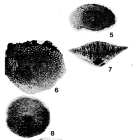Foraminifera taxon details
Clypeorbis Douvillé, 1915 †
722356 (urn:lsid:marinespecies.org:taxname:722356)
accepted
Genus
Orbitoides mamillata Schlumberger, 1902 † accepted as Clypeorbis mamillatus (Schlumberger, 1902) † (type by original designation)
Orbitoides (Clypeorbis) H. Douvillé, 1915 † · unaccepted (Opinion of Loeblich & Tappan,...)
Opinion of Loeblich & Tappan, 1987 Nomen translatum
marine, brackish, fresh, terrestrial
fossil only
masculine
(of Orbitoides (Clypeorbis) H. Douvillé, 1915 †) Douvillé, H. (1915). Les Orbitoïdes: développement et phase embryonnaire; leur évolution pendant le Crétacé. <em>Comptes Rendus hebdomadaires des séances de l'Académie des Sciences.</em> 161 (22): 664-670.
page(s): p. 669 [details]
page(s): p. 669 [details]
Hayward, B.W.; Le Coze, F.; Vachard, D.; Gross, O. (2024). World Foraminifera Database. Clypeorbis Douvillé, 1915 †. Accessed at: https://marinespecies.org/foraminifera/aphia.php?p=taxdetails&id=722356 on 2024-08-30
Date
action
by
original description
(of Orbitoides (Clypeorbis) H. Douvillé, 1915 †) Douvillé, H. (1915). Les Orbitoïdes: développement et phase embryonnaire; leur évolution pendant le Crétacé. <em>Comptes Rendus hebdomadaires des séances de l'Académie des Sciences.</em> 161 (22): 664-670.
page(s): p. 669 [details]
basis of record Loeblich, A. R.; Tappan, H. (1987). Foraminiferal Genera and their Classification. Van Nostrand Reinhold Company, New York. 970pp., available online at https://books.google.pt/books?id=n_BqCQAAQBAJ [details] Available for editors [request]
[request]
page(s): p. 669 [details]
basis of record Loeblich, A. R.; Tappan, H. (1987). Foraminiferal Genera and their Classification. Van Nostrand Reinhold Company, New York. 970pp., available online at https://books.google.pt/books?id=n_BqCQAAQBAJ [details] Available for editors
From editor or global species database
Diagnosis Test of moderate size, commonly 2 mm to 5 mm in diameter and may be up to 8 mm, asymmetrical, subconical, large protoconch at the apex of the cone followed by trochospiral early stage and very thin equatorial layer of arcuate chambers situated in a plane below that of the protoconch, equatorial chambers becoming hexagonal toward the test periphery, equatorial layer flanked by numerous lateral chambers on both sides but the more elevated side of the test with a thick protruding central pillar that begins at the protoconch and widens rapidly toward the exterior, lateral chambers adjacent to the pillar larger than other lateral chambers and appear to have a spiral arrangement; wall calcareous, perforate, surface may have pustules on both sides. U. Cretaceous (U. Maastrichtian); S. France; N. Spain. (Loeblich & Tappan, 1987, Foraminiferal Genera and Their Classification) [details]
